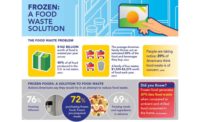Global awareness of food waste and its negative impact on the environment continue to grow, and so does the importance of the role that packaging plays in preventing it.
For instance, 1.3 billion tons of food is lost or wasted every year, costing around $680 billion in industrialized countries and $310 billion in developing countries, according to the Food and Agriculture Organization (FAO), Italy. When discarded food rots in the landfills, it emits methane, a strong greenhouse gas, causing a negative impact on the environment. Packaging that extends the case life of food helps address this issue by keeping more food out of landfills.
Throughout the food supply chain, food waste reduction isn’t just a moral responsibility; it also presents major business benefits. In fact, research on behalf of Champions 12.3, a unique coalition of leaders from government, business and civil society around the world dedicated to inspiring ambition, mobilizing action, and accelerating progress toward achieving SDG Target 12.3, finds that for every $1 companies invested to reduce food loss and waste, they saved $14 in operating costs.
What’s more, consumers are taking notice, opening the door to new growth opportunities for processors and retailers.
Furthermore, a study produced by Mintel, Chicago, revealed that packaging innovations that extend food freshness, preserve ingredient fortification and ensure product safety as increasingly benefiting consumers on a global scale were dubbed the top packaging trends in 2018. Indeed, 50% of U.S. grocery shoppers agree that the right packaging can help reduce food waste.
Consumers want it all, and processors can help
With more choices than ever in the meat and poultry cases, consumers are demanding more from their food products. In addition to the desire for food to remain fresher longer, they are interested in conveniences that include package quantity options, freezer-ready and leak-proof packaging.
Package transparency is also more important than ever to consumers, processors and retailers alike. Consumers want to be able to see the product they are buying, while processors and retailers want to differentiate product and attract consumer attention with product and packaging that look great in the case.
The demands are fierce and provide an opportunity
At the same time, processors are looking for ways to increase operational efficiencies through reductions in food waste throughout the journey from source to shelf.
With increasing demands from all sides, one issue is top of mind for all. The cost of food waste affects everyone, and people are now actively seeking solutions.
Today, food packaging continues to evolve, transitioning from a container meant to simply hold food to something that can play a more active role in food quality and safety as well as sustainability.
Longer case life means less discarded food and less waste. In the long run, that benefits everyone -- processors, retailers, foodservice operators, consumers and the planet.
Consider this. For one pound of edible beef to reach the consumer, it takes more than 600 gallons of water, 1.8 pounds of grain and 50 pounds of CO2. When food is discarded, these resources are essentially wasted.
And, the cost implications are enormous. An estimated 50 million tons of food, or more than one-third of the food produced annually in the Unites States, is disposed of before it can be consumed – a total representing nearly $160 billion in lost value, according to the “2014 Power of Meat report,” produced by the Food Marketing Institute, Arlington, Va.
Getting rid of the waste
Solutions like vacuum skin packaging help answer food waste issues with packaging innovations that extend food freshness.
And, that means consumers can purchase these proteins with confidence. When food lasts longer in their own refrigerator, they have extra time to plan meals before the use-by date. If schedules change, vacuum skin packaging can go straight into the freezer, with no need to re-package for use at a later date. And, features like easy-opening make meal preparation simpler. All these conveniences make it easier for consumers to keep from wasting the food they buy.
As processors and retailers face added pressure to reduce costs, state-of-the-art packaging can serve as a differentiator that delivers value in a crowded meat case.
How processors can grow their bottom line
Processors also have the ability to expand business through a variety of innovative packaging solutions that address the multitude of consumer desires.
Faster packaging reduces the costs for processors by increasing productivity as measured in pounds per man-hour, and reduces capital investment costs and costs related to utilities, such as water and electricity.
Influencing responsible behavior throughout the value chain
Sustainable food packaging has evolved to address myriad concerns, allowing processors and retailers to meet business objectives in both sustainability and sales.
Sustainable packaging benefits all:
- With proteins that stay fresh longer, from prep and holding to delivery, so consumers can enjoy mealtime experience with the confidence that they are preparing fresh, great tasting foods.
- By reducing the waste of packaging materials throughout the packaging process and its distribution cycle.
- Minimizing waste by extending case life from days to weeks or longer with vacuum seal technology.



